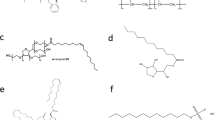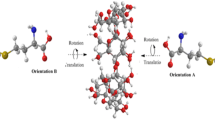Abstract
Purpose. To determine the mechanism and identify forces of interactionbetween polyaspartic acid and diminazene (a model drug). Such knowledgeis essential for the design of polymeric drug delivery systemsthat are based on molecular self-assembly into complexes or micellartype systems.
Methods. Complex formation was studied by isothermal titrationmicrocalorimetry and the McGhee von Hippel model was applied toobtain K obs, ΔH obs, and n obs. The calorimetry data were compared withboth an optical density study and the amount of free/complexed drug.
Results. The diminazene-polyaspartic acid interaction is enthalpicallydriven, whereby one diminazene molecule interacts with two monomersof polyaspartic acid. The dependence of K obs on saltconcentrationreveals a contribution of electrostatic interactions. However, applyingManning's counter ion condensation theory shows that the major drivingforce for the complex formation is hydrogen bonding, with interfacialwater molecules remaining buried within the complex. Themodelling of the pH dependence of K obs and ΔH obsdemonstrates thatthe ionization of carboxylic groups of polyaspartic acid is a prerequisitefor the interaction.
Conclusions. Complex formation between diminazene and polyasparticacid is driven by both electrostatic interactions and hydrogen bonding,with the latter being the dominating force. Although electrostaticinteractions are not the major driving force, ionization of the drug andpolymer is essential for complex formation.
Similar content being viewed by others
REFERENCES
G. S. Kwon, M. Naito, K. Kataoka, M. Yokoyama, Y. Sakurai, and T. Okano. Block copolymers micelles as vehicles for hydrophobic drugs. Colloids Surf. 2:429–434 (1994).
G. S. Kwon and K. Kataoka. Block copolymer micelles as long circulating drug vehicles. Adv. Drug Deliv. Rev. 16:295–309 (1995).
M. Yokoyama. Novel passive targetable drug delivery with polymeric micelles. In: Okano, T. (Ed.). Biorelated polymers and gels: Controlled Release and applications in biomedical engineering. Academic Press, Boston, pp. 193–229, 1998.
A. Harada and K. Kataoka. Novel polyion complex micelles entrapping enzyme molecules in the core: Preparation of narrowly distributed micelles from lysozyme and poly(ethylene glycol)-poly(aspartic acid) block copolymer in aqueous medium. Macro-molecules 31:288–294 (1998).
E. Tomlinson and A. P. Rolland. Controllable gene therapy. Pharmaceutics of non-viral gene delivery systems. J. Contr. Rel. 39:377–372 (1996).
T. Wiseman, S. Williston, J. F. Brandts, and L. N. Lin. Rapid measurement of binding constants and heats of binding using a new titration calorimeter. Anal. Biochem. 179:131–137 (1989).
M. L. Doyle. Characterisation of binding interactions by isothermal titration calorimetry. Curr. Opin. Biotechnol. 8:31–35 (1997).
R. J. Willson, A. E. Beezeer, and J. C. Mitchell. Solid state reactions studied by isothermal microcalorimetry; the solid state oxidation of ascorbic acid. Int. J. Pharm. 132:45–51 (1996).
K. Kataoka. Design of nanoscopic vehicles for drug targeting based on micellisation of amphiphilic block copolymers. J.M.S.-Pure Appl.Chem. A31:1759–1769 (1994).
S. Roweton, S. J. Huang, and G. Swift. Poly(aspartic acid): Synthesis, biodegradation and current applications. J. Env. Polym. Deg. 5:175–181. (1997).
G. J. Kaloyanides. Drug-phospholipid interactions-role in amino-glycoside nephrotoxicity. Renal Failure. 14:351–357 (1992).
J. D. McGhee and P. H. von Hippel. Theoretical aspects of DNA-protein interactions: co-operative and non-co-operative binding of large ligands to a one-dimensional homogeneous lattice. J. Mol. Biol. 86:469–489 (1974).
T. Govender, T. Ehtezazi, S. Stolnik, L. Illum, and S.S. Davis. Complex formation between the anionic polymer (polyaspartic acid) and a cationic drug (procaine HCl): characterization by microcalorimetric studies. Pharm. Res. 16:1125–1131 (1999).
T. Lundback, H. Hansson, S. Knapp, R. Ladenstein, and T. Hard. Thermodynamic characterization of non-sequence-specific DNA-binding by the Sso7d protein from sulfolobus solfataricus. J. Mol. Biol. 276:775–786 (1998).
E. C. Petrella, L. M. Machesky, D. A. Kaiser, and T. D. Pollard. Structural requirements and thermodynamics of the interaction of proline peptides with profilin. Biochemistry 35:16535–16543 (1996).
G. S. Manning. Limiting laws and counterion condensation in polyelectrolyte solution. I. Colligative properties. J. Chem. Phys. 51:924–933 (1969).
V. K. Misra, K. A Sharp, R. A. Friedman, and B. Honig. Salt effects on ligand-DNA binding minor groove binding antibiotics. J. Mol. Biol. 238:245–263. (1994).
P. Wang and I. Ando. A NMR study of structure and dynamic poly(aspartic acid) sodium salt. J. Mol. Struct. 447:81–88 (1998).
I. Haq, P. Lincoln, D. Suh, B. Norden, B. Z. Chowdhry, and J. B. Chaires. Interaction of ?-and ?-[Ru(phen)2DPPZ]2+ with DNA: A calorimetric and equilibrium binding study. J. Am. Chem. Soc. 117:4788–4796 (1995).
P. D. Ross and S. Subramanian. Thermodynamics of protein association reactions: forces contributing to stability. Biochemistry 20:3096–3102 (1981).
T. N. Bhat, G. A. Bently, G. Boulot, M. I. Greene, D. Tello, W. Dall’ Acqua, H. Souchon, F. P. Schwarz, and R. A. Mariuzza. Bound water molecules and conformational stabilization help mediate an antigen-antibody association. Proc. Natl. Acad. Sci., USA. 91:1089–1093 (1994).
P. L. deHaseth, T. M. Lohman, M. T. Record Jr. Nonspecific interaction of lac repressor with DNA: An association reaction driven by counterion release. J. Mol. Biol. 107:145–158 (1977).
D. P. Mascotti and T. M. Lohman. Thermodynamics of single stranded RNA binding to oligolysines containing. Biochemistry 31:8932–8946 (1992).
B. Lee and G. Graziano. A two-state model of hydrophobic hydration that produces compensating enthalpy and entropy changes. J. Am. Chem. Soc. 118:5163–5168 (1996).
P. R. Connelly, R. A. Aldape, F. J. Bruzzese, S. P. Chambers, M. J. Fitzgibbon, M. A. Fleming, S. Itoh, D. J. Livingston, M. A. Navia, J. A. Thomson, and K. P. Wilson. Enthalpy of hydrogen bond formation in a protein-ligand binding reaction. Proc. Natl. Sci. USA. 91:1964–1968 (1994).
L. G. Fuentes, A. Camara-Artigas, O. Lopez-Mayorga, and C. Baron. Thermodynamic characterization of 5'-AMP binding to bovine live glycogen phosphorylase a. J. Biol. Chem. 271:27569–27574 (1996).
D. K. Srivastava, S. Wang, and K. L. Peterson. Isothermal titration microclorimetric studies for the binding of octenoyl-coA to medium chain acyl-coA dehydrogenase. Biochemistry 36:6359–6366 (1997).
Author information
Authors and Affiliations
Rights and permissions
About this article
Cite this article
Ehtezazi, T., Govender, T. & Stolnik, S. Hydrogen Bonding and Electrostatic Interaction Contributions to the Interaction of a Cationic Drug with Polyaspartic Acid. Pharm Res 17, 871–877 (2000). https://doi.org/10.1023/A:1007520628237
Issue Date:
DOI: https://doi.org/10.1023/A:1007520628237




